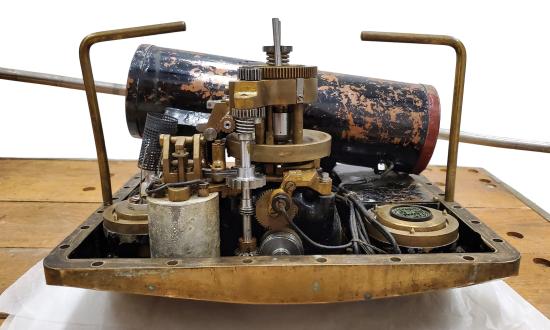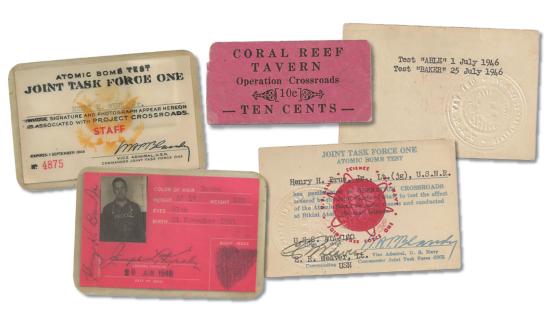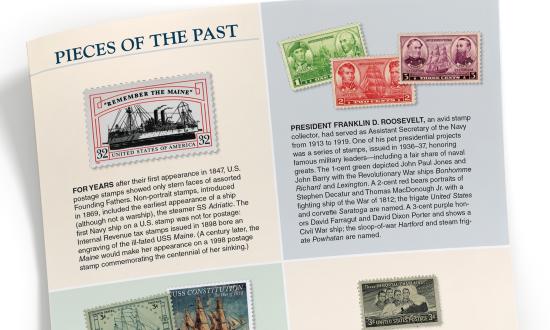The history of U.S. naval aviation, at least up to the start of the jet age, is celebrated on a number of U.S. postage stamps. Collectors usually reference stamps by their “Scott numbers” in the Scott Standard Postage Stamp Catalogue.
For the 50th anniversary of naval aviation in 1961, a 4-cent stamp depicted the Navy’s first flying machine, a Curtiss Model E-8-75 (Navy designation, A-1), purchased for $4,400 in 1911. Lieutenant Theodore G. Ellyson (1885–1928) became the first naval aviator, piloting this fragile biplane in a takeoff from Keuka Lake, New York, on 8 May 1911. The Navy eventually acquired 14 of these craft. The stamp (Scott 1185) also features an image of the “wings of gold” worn by naval aviators.
Designed as a fast executive transport with a five-passenger cabin, the Beechcraft Model 17, introduced in 1933, was an unusual biplane, with the upper wing set farther back than the lower one, leading to the nickname “Staggerwing.” In U.S. Navy service it was designated GB-1 (20 built) or GB-2 (271 built). In 1997, the U.S. Postal Service issued a sheet of 20 32-cent stamps illustrating different classic U.S. aircraft. One of these (Scott 3142j) features a painting of the Staggerwing in wartime Navy colors.
In the years before World War II, the Stearman Model 75 biplane was a basic trainer used by both the Army and the Navy. Introduced in 1934, in Navy service it was designated NS or N2S. That same year, the Stearman Aircraft Company was acquired by Boeing. More than 10,000 of these rugged and reliable single-engine, twin-seat biplanes were built. (An N2S-3 on static display at the National Naval Aviation Museum in Pensacola, Florida, was flown by former President George H. W. Bush during his training as a Navy pilot.) A painting of a bright yellow Stearman in flight appears on one of the 1997 32-cent stamps (Scott 3142l).
In 2005, the U.S. Postal Service issued a sheet of ten 37-cent stamps featuring “American Advances in Aviation” (Scott 3917). One of these bears a painting of the Consolidated PBY Catalina, a twin-engine flying boat that entered service in 1936. Some 1,870 were built for the Navy, with thousands more going to the Army, Coast Guard, and Allies during World War II. Catalinas served in many missions: maritime patrol, antisubmarine warfare, search-and-rescue, and logistics. Hundreds of downed aviators and shipwrecked sailors were saved by the versatile PBY.
Between 1938 and 1941, Boeing constructed a dozen Model 314 “Clipper” four-engine flying boats. Operated on transpacific routes by Pan American World Airways, it was the world’s longest-ranged aircraft at the time. Taken into Navy service after the outbreak of World War II, some Clippers continued to operate with their experienced civilian crews. Three were sold to the British and carried Winston Churchill on some of his wartime travels. In 1943, a Clipper carried President Franklin D. Roosevelt to the Casablanca Conference. After the war, the surviving aircraft were scrapped. A painting of a Clipper landing at sea appears on the 1997 sheet of 32-cent stamps (Scott 3142r).
Designed by the legendary Ed Heinemann, the Douglas SBD Dauntless dive bomber was one of the Navy’s most successful carrier-based aircraft of World War II. Sailors joked that the plane’s SBD designation stood for “slow but deadly.” A dozen SBDs from the carriers USS Enterprise (CV-6) and Yorktown (CV-5) sank four Japanese carriers in the decisive Battle of Midway. More than 5,900 SBDs were built between 1940 and 1944. In 1992, a sheet of ten 29-cent stamps (Scott 2697c) commemorating the 50th anniversary of the war included a dramatic image of an SBD launching from a carrier deck during the Battle of the Coral Sea.
The Grumman F4F Wildcat fighter entered service in 1940. Serving with the U.S. Navy, the Marine Corps, and the Royal Navy, some 7,785 were built during the war. Although the Japanese A6M Zero fighter was faster, longer-ranged, and more agile, the Wildcat achieved a wartime kill ratio of nearly 7:1. A painting of a Wildcat in early wartime colors adorns one of the 1997 32-cent stamps (Scott 3142t).
The B-24 Liberator was designed as a heavy bomber, but it proved very effective in Navy and Coast Guard service as the PB4Y long-range maritime patrol and antisubmarine aircraft; 976 were built. A painting of a B-24 in flight, in Army colors, appears on a 37-cent stamp from 2005 (Scott 3922).
The Vought F4U Corsair was the most effective carrier-based fighter of World War II, with an 11:1 kill ratio. Its first flight was in 1940, but technical problems with carrier landing delayed entry into Navy service in large numbers until late 1944. The Marines flew it successfully from land bases beginning with the Guadalcanal campaign early in 1943. More than 12,000 were built before production ended in 1953. The unusual “bent” wing design was chosen to allow the landing gear to provide sufficient ground clearance for a very large propeller. A painting of a Navy Corsair in flight appears on one of the 1997 “Classic American Aircraft” 32-cent stamps (Scott 3142g).
—Michael Markowitz, research specialist, Center for Naval Analyses; contributing writer, CoinWeek.com















